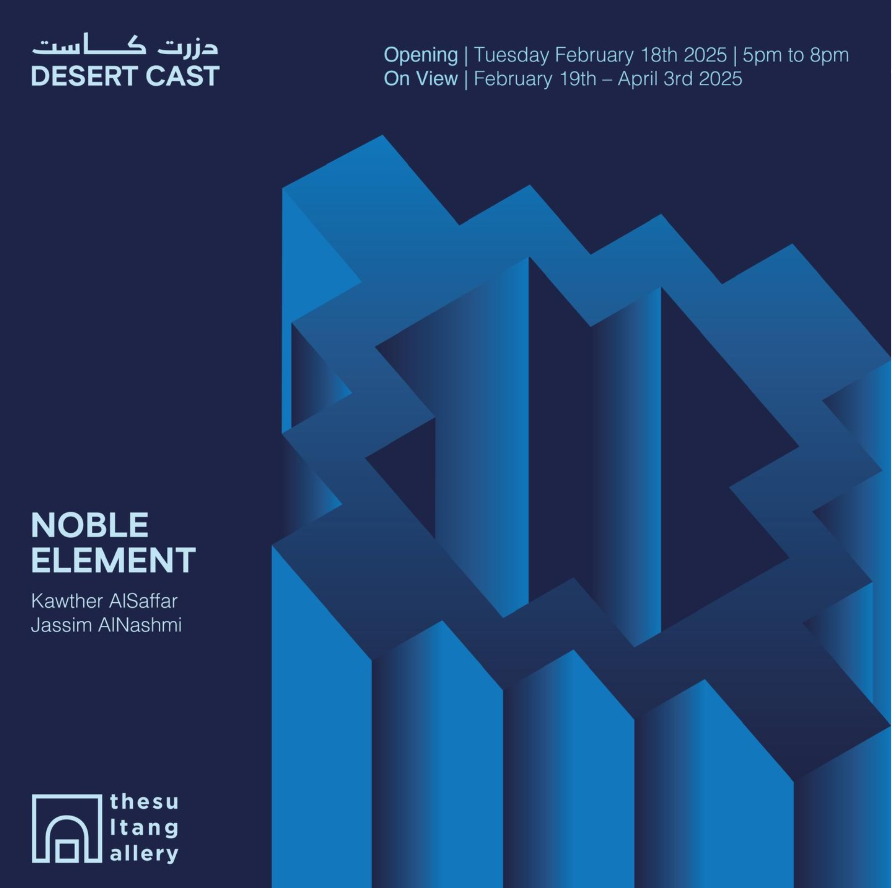NOBLE ELEMENT
EXHIBITION HISTORY
Desert Cast is a collective of two Kuwait-based designers Kawther Alsaffar and Jassim Alnashmi. The duo exhibited the first collection titled XLVI in Dubai Design Week 2018 Kuwait City Pavilion, where 46 Kuwaiti sand-cast sculptural stools were displayed.
After the Desert Cast debut in DDW, The XLVI stools were exhibited in multiple renowned galleries including the Jameel Arts Center and Future Perfect Gallery in New York.
In 2020 the collective further elaborated on Kuwait’s design identity by presenting a solo exhibition in 1971 Design Space on Flag Island, Sharjah. This included a monolithic gypsum plinth, a wall of gypsum profiles, an extrusion performance table, and 14 miniature blue copper-patinated sculptures. By advancing the production technology, the exhibition titled Towards an Identity told a story about Kuwait’s inherited vernacular and contemporary design potential.
The scale and functionality of Towards an Identity was further expanded through a batch of sculptures commissioned by 1971 for MENASA in Expo 2020. The batch included a series of collectable scale like paperweight sculptures and wall-mounted pieces, with new copper, brass and blue finishes.
After this the next Desert Cast commission was 3 large scale pieces exhibited in Arab Design Now in Doha, Qatar 2023. These pieces further pushed the limits of production in Kuwait as they were the largest sculptures cast to date. The biggest piece, titled the snake is 160cm in length and 84kg of solid aluminium.
Noble Element is the final solo Desert Cast exhibition. Focusing on the collective in-depth research into chemical patination from 2020 and beyond.
PROCESS EXPLANATION
Desert Cast merges CAD design, foam cutting technology and sand-casting in unprecedented applications. The first Desert Cast collection of sculptural stools Series XLVI combined the process of single-directional foam-extrusion with lost-foam-casting, a process that allows the casting of undercut objects, which is not usually possible in traditional sand-casting. The new collection uses two directional foam cutting to create forms that are more visually complex and appear to be shaped in all axes. The pieces are partially copper dipped to further exaggerate the contrast between the modern aesthetics and traditional casting. The collection shows the extensive potential of localised application of technology and ancient craft.
CONCEPT STATEMENT
Hybridising motifs of Kuwait’s past and present, the series titled Desert Cast contributes to the development of local design identity through its re-application of regional and borrowed elements.
This collection analyses the kitsch replication of classical architectural motifs in Kuwaiti houses. A trend that creates a disingenuous sense of vicarious and exotic luxury, and contributes to Kuwait's struggle to develop a context-based design identity, due to an orientalist over-generalisation of Middle Eastern culture.
Desert Cast borrows the profiles used for extruded gypsum cornices and friezes, morphing them by overlapping the designs with two other locally embellished processes, sand-casting, and foam-cutting.
Synthesising local craft and design technology establishes a new Kuwaiti identity that is rooted in its migrant history, yet embraces its contemporary image. The series highlights the accessibility to master craftsmanship, typically used in a narrow practice, with limited perceived value, and presents new possibilities.
NOBLE ELEMENT
Noble Element, focuses on the challenges of creating Desert Cast’s blue copper tones using chemical oxidation. It centres the complications of shifting regulations on copper importation in Kuwait, particularly copper cyanide, which is crucial for plating. Globalisation often overshadows the importance of local craft and material research.However many significant design movements historically emerged as a response to political limitations. Noble Element is the culmination of seven-years of research underscoring the struggles and abject beauty of preserving a fragile ecosystem of craft in Kuwait, which faces threats from the political climate and the exodus of skilled individuals.






